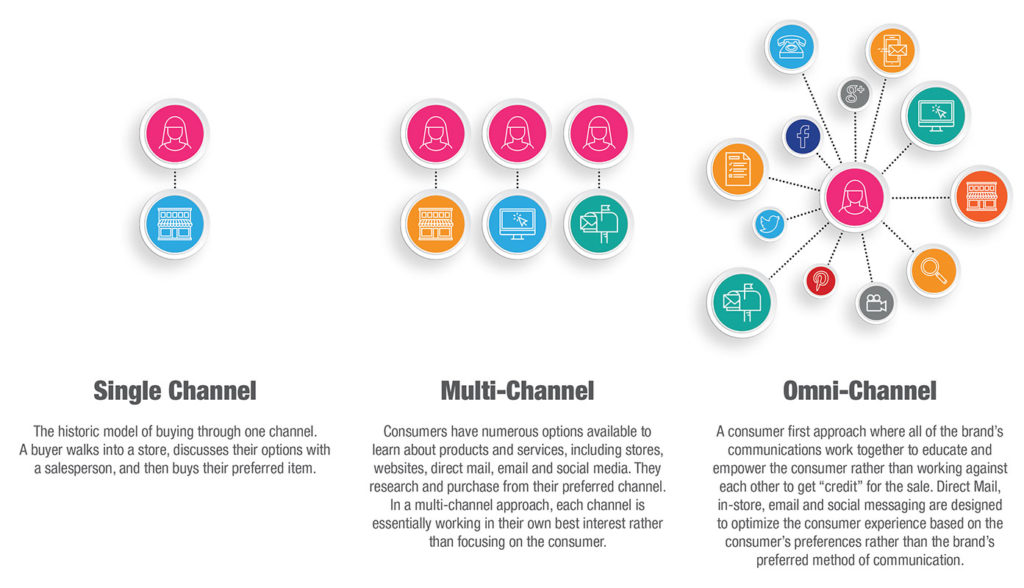The world of marketing has grown exponentially more complex in recent years in direct proportion to the number of channels available to consumers. Along with that growth has come the rise of a concept worth closer examination: omni-channel marketing campaigns.
At their most basic, omni-channel campaigns are the logical follow-up to multi-channel marketing. But the difference between the two is distinct: Multi-channel marketing is focused on the sale. Omni-channel marketing campaigns focus on the customer. Knowing and understanding the difference between them is critical to the successful implementation of an omni-channel marketing effort. It means the end of ‘sales silos’, and instead focuses on the overall customer experience.
The Evolution of Omni-Channel Marketing Campaigns:
“An omni-channel approach puts the customer, not corporate silos, at the center of its strategy,” noted Stacy Schwartz. Stacy is a digital marketing expert and adjunct professor at Rutgers Business School. “It acknowledges that mobile and social have enabled customers to not only quickly switch between channels, but actually use channels simultaneously.”
But what does an omni-channel experience actually look like? John Bowden, Senior VP of Customer Care at Time Warner Cable, explains:
“Multi-channel is an operational view – how you allow the customer to complete transactions in each channel. Omni-channel, however, is viewing the experience through the eyes of your customer, orchestrating the customer experience across all channels so that it is seamless, integrated, and consistent. Omni-channel anticipates that customers may start in one channel and move to another as they progress to a resolution. Making these complex ‘hand-offs’ between channels must be fluid for the customer. Simply put, omni-channel is multi-channel done right!”

There are a number of elements that make up a strong omni-channel marketing strategy, worth keeping in mind as you build out your sites:
Availability is Key for Omni-Channel Marketing
Consumers like choice. With today’s connection options, they want to be able to discover everything they can about your product whenever they want, the way they want. That means upping your business productivity and building out your presence so it offers connectivity no matter how your customers find you. This also goes for a mobile device, desktop device, through social media, via kiosks or even a brick and mortar store.
Related: The World of QR Codes is Changing: Can Your Marketing Keep Up?
Be Consistent With Omni-Channel Marketing Campaigns
Once you commit to an omni-channel narketing strategy, stay on top of it. Monitor social media about your brand, and if you see any complaints or concerns expressed, address them immediately, because consumers can be a fickle bunch. EMarketer reports 56% of U.S. consumers told strategy and consulting company Accenture that “the number of brands they considered had increased significantly in the past 10 years. Nearly half of those surveyed also said they were more likely to switch brands than they were 10 years ago.” Your global brand needs careful, ongoing management, as this blog on Global Brand Management shows. Don’t take customers for granted. They have other options.
Related: Your Brand Needs a Brand Portal: Here’s Why
Omni-Channel Campaigns Should Stay Channel-Neutral

The ‘Seamless’ Omni-Channel Experience
While customers don’t actively seek out a reason to switch brands, they will for myriad reasons. So it makes sense to assure that every touchpoint they have in an omni-channel experience with your brand delights and excites them. “With omni-channel marketing campaigns, the same basket data, inventory, promotions, customer account information, and purchase history should be available in all channels,” notes UX (User Experience) Magazine. That means that once a customer engages with you on one channel (for example, putting a purchase in a shopping cart and then leaving that channel), they should be able to resume that shopping activity from another touch-point, with all previous data and input-information intact.
Related: Making Sense of ‘Acronym Soup’: Marketing Communications Clarified
“The importance of creating one-on-one experiences lies at the heart of the omni-channel marketing approach,” said Daniel Newman, president of Broadsuite Media Group, a leader in the B2B space. “Whether it’s B2B or B2C, modern purchasing behavior is driven by personalized engagement. This is where omni-channel marketing really hits the mark. By letting the buyer control the process and steer it whichever way she wants, you ensure her experience remains seamless. It’s consistent from start to the finish, and perhaps even beyond that.”
Omni-channel interactions are the new wave in the customer experience, and they’re here now. By incorporating such technology into your organization, you send the message that the customer is your number one priority. Increased response, purchase frequency and customer loyalty will follow.
Omni-Channel Marketing Checklist
Are you creating a truly omni-channel experience for your customers? Use this free interactive checklist to find out.
Fintech Marketing Strategy: 10 Ways to Build Your Financial Brand
Financial services marketing has traditionally been a somewhat bland business offering—at least as far as consumers are concerned. But that's exactly why modern-day marketing tactics have had to adapt—to meet people's ever-changing needs. Fintech answers that call in...
The Essential Guide to Car Dealership Marketing
For auto industry marketers, there have been some important changes to negotiate over the past year. COVID-19 caused a decrease in sales and changed car dealership marketing habits. But there's good news. As the world begins to "reopen," more people will be looking to...
Marketing for Hospitality and Tourism: A 7-Step Roadmap to Success
When you're marketing for hospitality and tourism, your goal is to create a foundation of loyal, satisfied customers. Of course, that's easier said than done. You have to know what your patrons need before they do. That means placing a priority on customer experience...









This is very interesting. I will be looking for ways to incorporate this into my business.
Omni channel marketing done well is a great business boost. The challenge is the time and resources it requires.
Great article. I have never heard of this type of Omni channel marketing but it seems like a great option for a small company.
We never heard of omni marketing before. This was a great write-up on this type of marketing.
Great article. Never heard of this type of marketing campaign! Definitely learned something new.
I have never heard of omni channel marketing before but based on what you shared I am intrigued. Definitely learned something.
I’ve been using my own version of this for a while now and not sure how I managed without it! I really need to take a look with this. Thank you for sharing
Great article. This is a topic I know I need to learn more about and you really helped me understand some good ways to get started. Thank you.
Never heard of this before so thanks for the insight. I know marketing is very big and also involve keeping up with trends.
Oh wow, I had no idea this marketing strategy was out there. it sounds pretty effective if it is consistent, I am glad to know about it now.
I have never heard of this and it’s awesome they are focused on the customer so much!!
Never heard of this type of marketing campaign! Very interesting!
Thanks, I am studying business administration. I haven’t heard about Omni channel. I think customer satisfaction is the end goal of every business and this strategy works entirely on it.
Thanks for letting us understand that omnichannel marketing is relevant to boost customer experience!
Since customers are more willing to switch brands than they were 10 years ago, we really need to stay on top of any complaints. Omni channel marketing helps with this.
This is very interesting. I hadn’t heard of omni channel marketing, but it is genius! Thanks, I learned something today!